Essay: HRM Strategies for Managing People and Organizations
VerifiedAdded on 2020/04/15
|11
|2779
|516
Essay
AI Summary
This essay provides a comprehensive overview of managing people and organizations, emphasizing the role of robust Human Resource Management (HRM) policies. It examines the interconnectedness of HRM with employee development, training, and engagement, aligning these elements with strategic HRM goals. The essay incorporates research-informed literature, offering insights into the impact of HRM practices on employee trust, the influence of globalization, and the challenges faced by HR managers. It delves into the practical application of HRM models, analyzing their impact on public organizations and the significance of employee motivation. The essay also explores the skills necessary for professional practice, highlighting the importance of team performance, performance-based pay, comprehensive selection procedures, and continuous training. The essay concludes by emphasizing the importance of strategic HRM in enhancing organizational performance and achieving a competitive advantage.
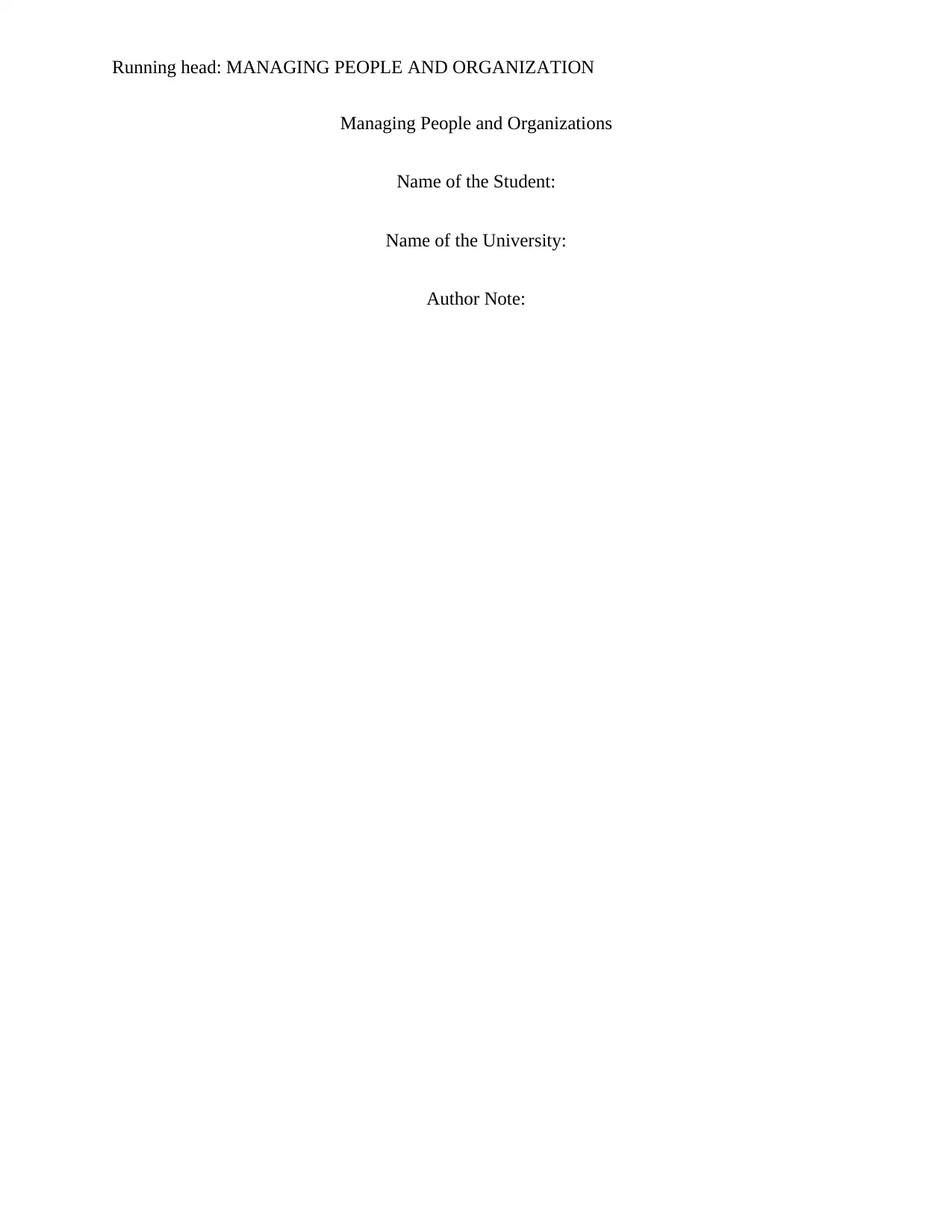
Running head: MANAGING PEOPLE AND ORGANIZATION
Managing People and Organizations
Name of the Student:
Name of the University:
Author Note:
Managing People and Organizations
Name of the Student:
Name of the University:
Author Note:
Paraphrase This Document
Need a fresh take? Get an instant paraphrase of this document with our AI Paraphraser

1MANAGING PEOPLE AND ORGANIZATION
Introduction:
The essay gives an overview of managing people and organization through robust and
progressive Human Resource Management (HRM) policies. The essay written following an
argumentative and balance approach with reference to the development, training and employee
engagement and how they can be linked to HRM strategy. The essay is divided into subsections
that includes research informed literature, knowledge and understanding of the subject, analysis,
practical application and deployment, skills necessary for professional practice followed by a
conclusion.
Research Informed Literature:
Researchers Alfes, Shantz and Truss (2012) in their studies have examined the
consequences of upcoming human resource management (HRM) practice for building employee
trust on their managers through a combination of resource based perspective and exchange
theory. Therefore, the research portrays the ways that ensures a linkage between the evolving
HRM practices and the trust of the employees on their managers. According to the framework
represented in the report the consequences of HRM represents a proxy where the behaviors,
actions and procedures influences the trust of the employees on the managers. This indicates a
positive and significant influence of organizational communication, empowerment and
procedural justice for building employee trust on their managers. Findings however indicate that
procedural justice helps in mediating the employee development impact on the managers’ trust.
There are also discussions on the implications of the strategic HR policies on the organizations.
There has been a transfer of the practices of human resource management across the
national borders that have become one of the vital strategies for multinational company in
Introduction:
The essay gives an overview of managing people and organization through robust and
progressive Human Resource Management (HRM) policies. The essay written following an
argumentative and balance approach with reference to the development, training and employee
engagement and how they can be linked to HRM strategy. The essay is divided into subsections
that includes research informed literature, knowledge and understanding of the subject, analysis,
practical application and deployment, skills necessary for professional practice followed by a
conclusion.
Research Informed Literature:
Researchers Alfes, Shantz and Truss (2012) in their studies have examined the
consequences of upcoming human resource management (HRM) practice for building employee
trust on their managers through a combination of resource based perspective and exchange
theory. Therefore, the research portrays the ways that ensures a linkage between the evolving
HRM practices and the trust of the employees on their managers. According to the framework
represented in the report the consequences of HRM represents a proxy where the behaviors,
actions and procedures influences the trust of the employees on the managers. This indicates a
positive and significant influence of organizational communication, empowerment and
procedural justice for building employee trust on their managers. Findings however indicate that
procedural justice helps in mediating the employee development impact on the managers’ trust.
There are also discussions on the implications of the strategic HR policies on the organizations.
There has been a transfer of the practices of human resource management across the
national borders that have become one of the vital strategies for multinational company in
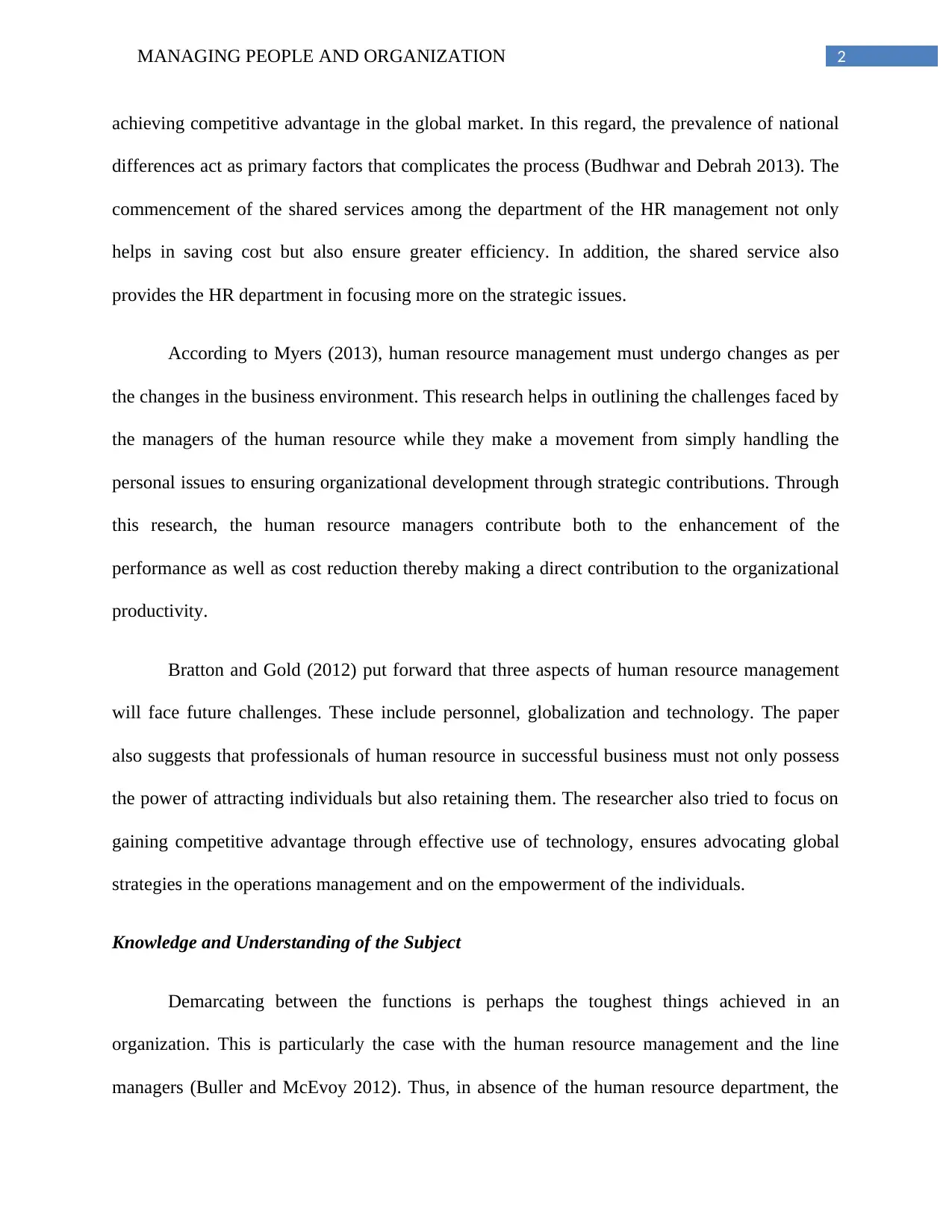
2MANAGING PEOPLE AND ORGANIZATION
achieving competitive advantage in the global market. In this regard, the prevalence of national
differences act as primary factors that complicates the process (Budhwar and Debrah 2013). The
commencement of the shared services among the department of the HR management not only
helps in saving cost but also ensure greater efficiency. In addition, the shared service also
provides the HR department in focusing more on the strategic issues.
According to Myers (2013), human resource management must undergo changes as per
the changes in the business environment. This research helps in outlining the challenges faced by
the managers of the human resource while they make a movement from simply handling the
personal issues to ensuring organizational development through strategic contributions. Through
this research, the human resource managers contribute both to the enhancement of the
performance as well as cost reduction thereby making a direct contribution to the organizational
productivity.
Bratton and Gold (2012) put forward that three aspects of human resource management
will face future challenges. These include personnel, globalization and technology. The paper
also suggests that professionals of human resource in successful business must not only possess
the power of attracting individuals but also retaining them. The researcher also tried to focus on
gaining competitive advantage through effective use of technology, ensures advocating global
strategies in the operations management and on the empowerment of the individuals.
Knowledge and Understanding of the Subject
Demarcating between the functions is perhaps the toughest things achieved in an
organization. This is particularly the case with the human resource management and the line
managers (Buller and McEvoy 2012). Thus, in absence of the human resource department, the
achieving competitive advantage in the global market. In this regard, the prevalence of national
differences act as primary factors that complicates the process (Budhwar and Debrah 2013). The
commencement of the shared services among the department of the HR management not only
helps in saving cost but also ensure greater efficiency. In addition, the shared service also
provides the HR department in focusing more on the strategic issues.
According to Myers (2013), human resource management must undergo changes as per
the changes in the business environment. This research helps in outlining the challenges faced by
the managers of the human resource while they make a movement from simply handling the
personal issues to ensuring organizational development through strategic contributions. Through
this research, the human resource managers contribute both to the enhancement of the
performance as well as cost reduction thereby making a direct contribution to the organizational
productivity.
Bratton and Gold (2012) put forward that three aspects of human resource management
will face future challenges. These include personnel, globalization and technology. The paper
also suggests that professionals of human resource in successful business must not only possess
the power of attracting individuals but also retaining them. The researcher also tried to focus on
gaining competitive advantage through effective use of technology, ensures advocating global
strategies in the operations management and on the empowerment of the individuals.
Knowledge and Understanding of the Subject
Demarcating between the functions is perhaps the toughest things achieved in an
organization. This is particularly the case with the human resource management and the line
managers (Buller and McEvoy 2012). Thus, in absence of the human resource department, the
⊘ This is a preview!⊘
Do you want full access?
Subscribe today to unlock all pages.

Trusted by 1+ million students worldwide
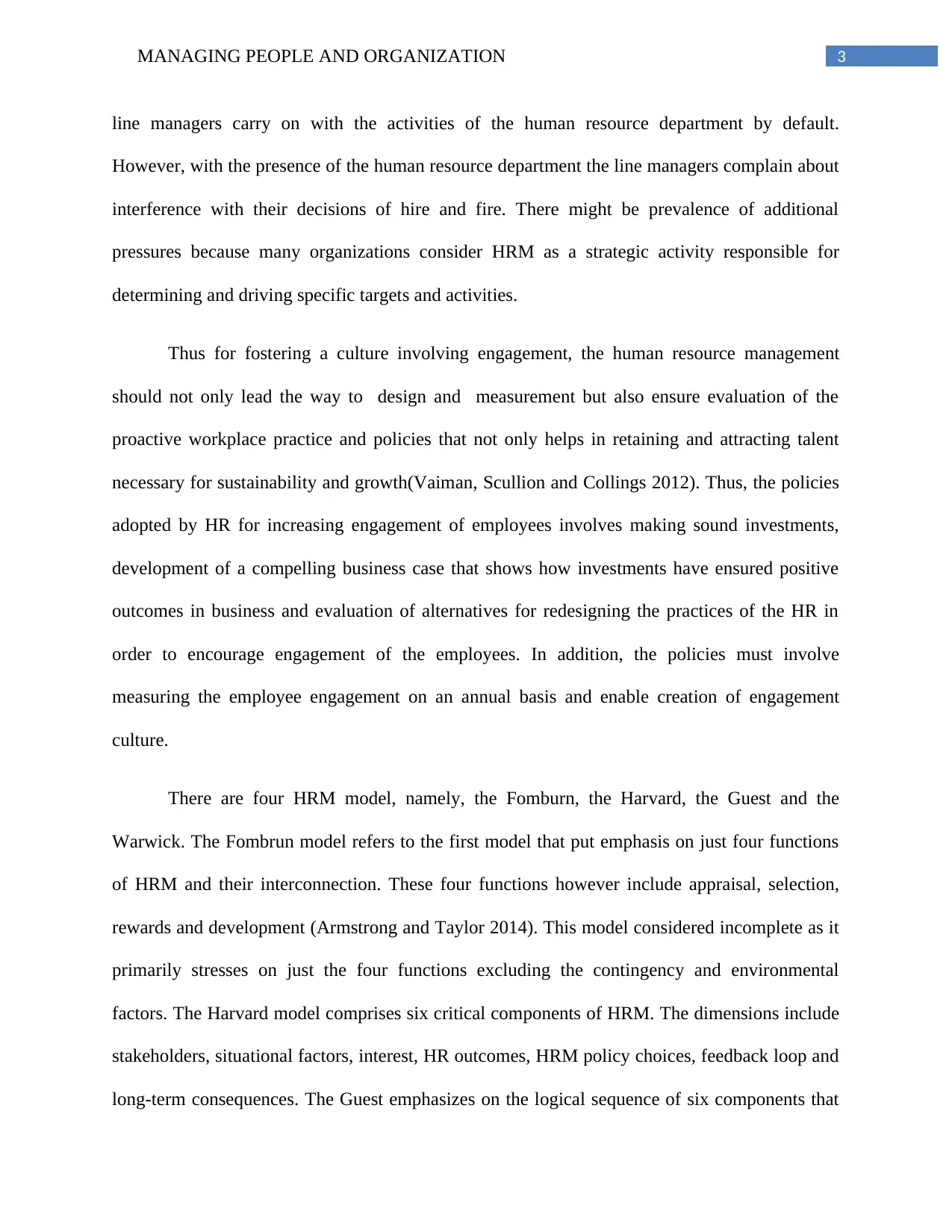
3MANAGING PEOPLE AND ORGANIZATION
line managers carry on with the activities of the human resource department by default.
However, with the presence of the human resource department the line managers complain about
interference with their decisions of hire and fire. There might be prevalence of additional
pressures because many organizations consider HRM as a strategic activity responsible for
determining and driving specific targets and activities.
Thus for fostering a culture involving engagement, the human resource management
should not only lead the way to design and measurement but also ensure evaluation of the
proactive workplace practice and policies that not only helps in retaining and attracting talent
necessary for sustainability and growth(Vaiman, Scullion and Collings 2012). Thus, the policies
adopted by HR for increasing engagement of employees involves making sound investments,
development of a compelling business case that shows how investments have ensured positive
outcomes in business and evaluation of alternatives for redesigning the practices of the HR in
order to encourage engagement of the employees. In addition, the policies must involve
measuring the employee engagement on an annual basis and enable creation of engagement
culture.
There are four HRM model, namely, the Fomburn, the Harvard, the Guest and the
Warwick. The Fombrun model refers to the first model that put emphasis on just four functions
of HRM and their interconnection. These four functions however include appraisal, selection,
rewards and development (Armstrong and Taylor 2014). This model considered incomplete as it
primarily stresses on just the four functions excluding the contingency and environmental
factors. The Harvard model comprises six critical components of HRM. The dimensions include
stakeholders, situational factors, interest, HR outcomes, HRM policy choices, feedback loop and
long-term consequences. The Guest emphasizes on the logical sequence of six components that
line managers carry on with the activities of the human resource department by default.
However, with the presence of the human resource department the line managers complain about
interference with their decisions of hire and fire. There might be prevalence of additional
pressures because many organizations consider HRM as a strategic activity responsible for
determining and driving specific targets and activities.
Thus for fostering a culture involving engagement, the human resource management
should not only lead the way to design and measurement but also ensure evaluation of the
proactive workplace practice and policies that not only helps in retaining and attracting talent
necessary for sustainability and growth(Vaiman, Scullion and Collings 2012). Thus, the policies
adopted by HR for increasing engagement of employees involves making sound investments,
development of a compelling business case that shows how investments have ensured positive
outcomes in business and evaluation of alternatives for redesigning the practices of the HR in
order to encourage engagement of the employees. In addition, the policies must involve
measuring the employee engagement on an annual basis and enable creation of engagement
culture.
There are four HRM model, namely, the Fomburn, the Harvard, the Guest and the
Warwick. The Fombrun model refers to the first model that put emphasis on just four functions
of HRM and their interconnection. These four functions however include appraisal, selection,
rewards and development (Armstrong and Taylor 2014). This model considered incomplete as it
primarily stresses on just the four functions excluding the contingency and environmental
factors. The Harvard model comprises six critical components of HRM. The dimensions include
stakeholders, situational factors, interest, HR outcomes, HRM policy choices, feedback loop and
long-term consequences. The Guest emphasizes on the logical sequence of six components that
Paraphrase This Document
Need a fresh take? Get an instant paraphrase of this document with our AI Paraphraser
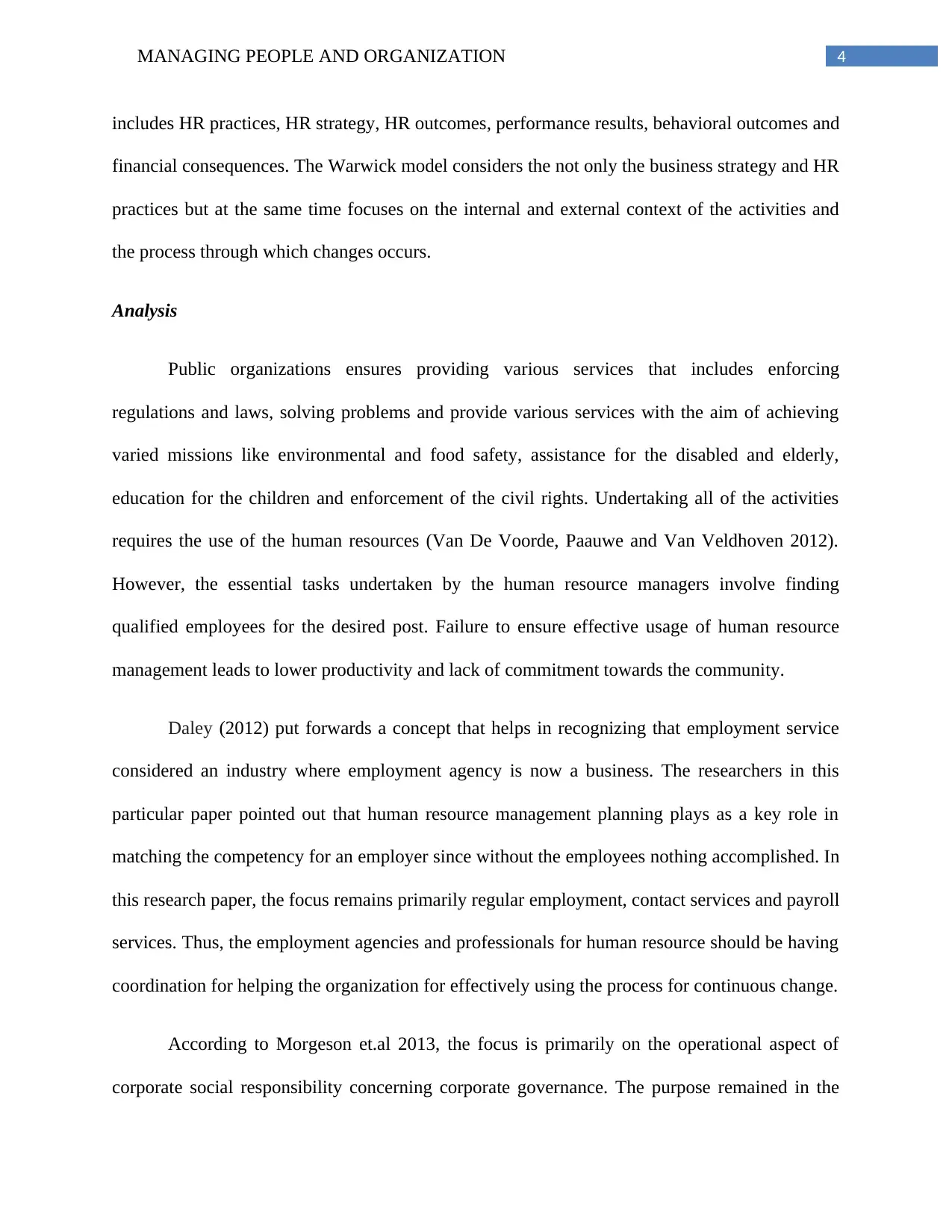
4MANAGING PEOPLE AND ORGANIZATION
includes HR practices, HR strategy, HR outcomes, performance results, behavioral outcomes and
financial consequences. The Warwick model considers the not only the business strategy and HR
practices but at the same time focuses on the internal and external context of the activities and
the process through which changes occurs.
Analysis
Public organizations ensures providing various services that includes enforcing
regulations and laws, solving problems and provide various services with the aim of achieving
varied missions like environmental and food safety, assistance for the disabled and elderly,
education for the children and enforcement of the civil rights. Undertaking all of the activities
requires the use of the human resources (Van De Voorde, Paauwe and Van Veldhoven 2012).
However, the essential tasks undertaken by the human resource managers involve finding
qualified employees for the desired post. Failure to ensure effective usage of human resource
management leads to lower productivity and lack of commitment towards the community.
Daley (2012) put forwards a concept that helps in recognizing that employment service
considered an industry where employment agency is now a business. The researchers in this
particular paper pointed out that human resource management planning plays as a key role in
matching the competency for an employer since without the employees nothing accomplished. In
this research paper, the focus remains primarily regular employment, contact services and payroll
services. Thus, the employment agencies and professionals for human resource should be having
coordination for helping the organization for effectively using the process for continuous change.
According to Morgeson et.al 2013, the focus is primarily on the operational aspect of
corporate social responsibility concerning corporate governance. The purpose remained in the
includes HR practices, HR strategy, HR outcomes, performance results, behavioral outcomes and
financial consequences. The Warwick model considers the not only the business strategy and HR
practices but at the same time focuses on the internal and external context of the activities and
the process through which changes occurs.
Analysis
Public organizations ensures providing various services that includes enforcing
regulations and laws, solving problems and provide various services with the aim of achieving
varied missions like environmental and food safety, assistance for the disabled and elderly,
education for the children and enforcement of the civil rights. Undertaking all of the activities
requires the use of the human resources (Van De Voorde, Paauwe and Van Veldhoven 2012).
However, the essential tasks undertaken by the human resource managers involve finding
qualified employees for the desired post. Failure to ensure effective usage of human resource
management leads to lower productivity and lack of commitment towards the community.
Daley (2012) put forwards a concept that helps in recognizing that employment service
considered an industry where employment agency is now a business. The researchers in this
particular paper pointed out that human resource management planning plays as a key role in
matching the competency for an employer since without the employees nothing accomplished. In
this research paper, the focus remains primarily regular employment, contact services and payroll
services. Thus, the employment agencies and professionals for human resource should be having
coordination for helping the organization for effectively using the process for continuous change.
According to Morgeson et.al 2013, the focus is primarily on the operational aspect of
corporate social responsibility concerning corporate governance. The purpose remained in the
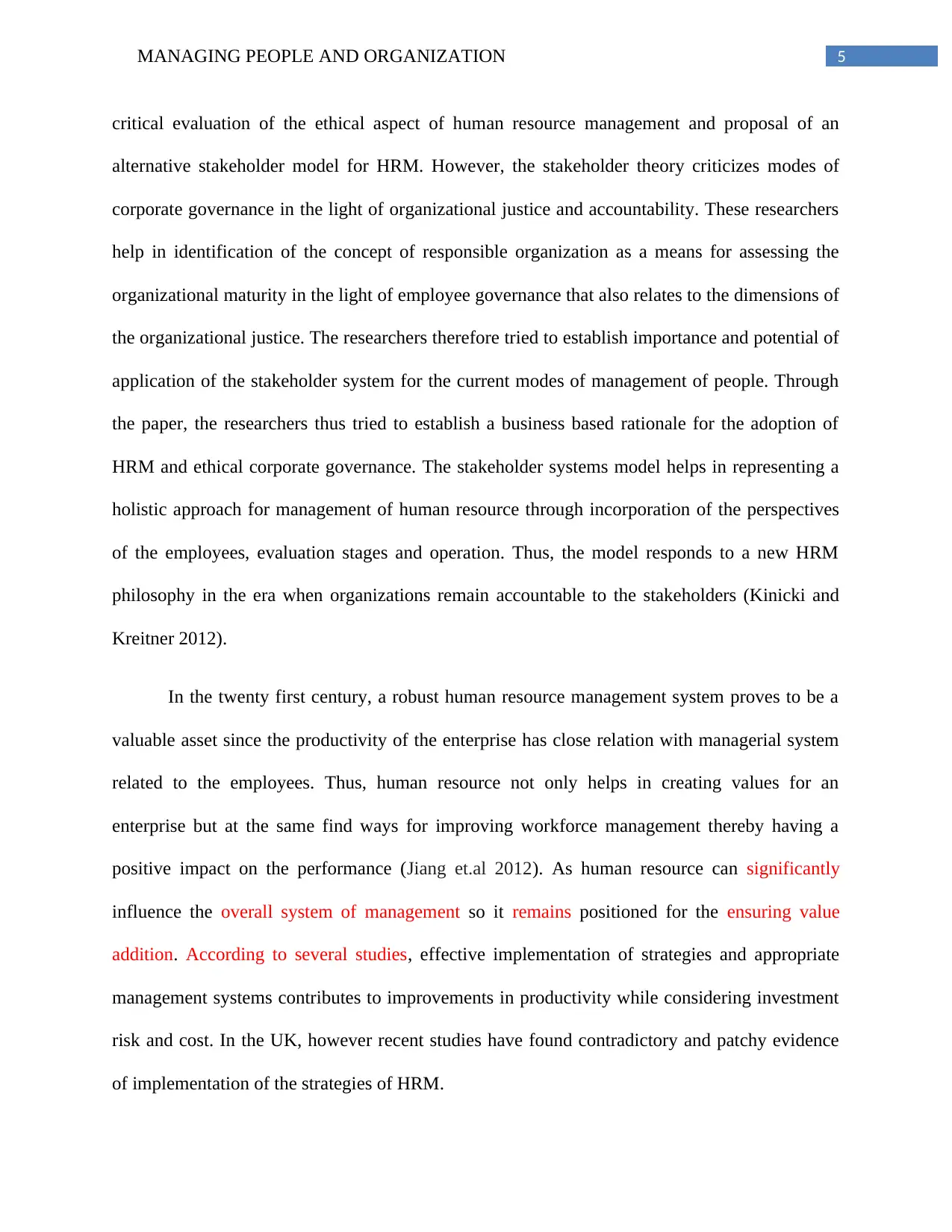
5MANAGING PEOPLE AND ORGANIZATION
critical evaluation of the ethical aspect of human resource management and proposal of an
alternative stakeholder model for HRM. However, the stakeholder theory criticizes modes of
corporate governance in the light of organizational justice and accountability. These researchers
help in identification of the concept of responsible organization as a means for assessing the
organizational maturity in the light of employee governance that also relates to the dimensions of
the organizational justice. The researchers therefore tried to establish importance and potential of
application of the stakeholder system for the current modes of management of people. Through
the paper, the researchers thus tried to establish a business based rationale for the adoption of
HRM and ethical corporate governance. The stakeholder systems model helps in representing a
holistic approach for management of human resource through incorporation of the perspectives
of the employees, evaluation stages and operation. Thus, the model responds to a new HRM
philosophy in the era when organizations remain accountable to the stakeholders (Kinicki and
Kreitner 2012).
In the twenty first century, a robust human resource management system proves to be a
valuable asset since the productivity of the enterprise has close relation with managerial system
related to the employees. Thus, human resource not only helps in creating values for an
enterprise but at the same find ways for improving workforce management thereby having a
positive impact on the performance (Jiang et.al 2012). As human resource can significantly
influence the overall system of management so it remains positioned for the ensuring value
addition. According to several studies, effective implementation of strategies and appropriate
management systems contributes to improvements in productivity while considering investment
risk and cost. In the UK, however recent studies have found contradictory and patchy evidence
of implementation of the strategies of HRM.
critical evaluation of the ethical aspect of human resource management and proposal of an
alternative stakeholder model for HRM. However, the stakeholder theory criticizes modes of
corporate governance in the light of organizational justice and accountability. These researchers
help in identification of the concept of responsible organization as a means for assessing the
organizational maturity in the light of employee governance that also relates to the dimensions of
the organizational justice. The researchers therefore tried to establish importance and potential of
application of the stakeholder system for the current modes of management of people. Through
the paper, the researchers thus tried to establish a business based rationale for the adoption of
HRM and ethical corporate governance. The stakeholder systems model helps in representing a
holistic approach for management of human resource through incorporation of the perspectives
of the employees, evaluation stages and operation. Thus, the model responds to a new HRM
philosophy in the era when organizations remain accountable to the stakeholders (Kinicki and
Kreitner 2012).
In the twenty first century, a robust human resource management system proves to be a
valuable asset since the productivity of the enterprise has close relation with managerial system
related to the employees. Thus, human resource not only helps in creating values for an
enterprise but at the same find ways for improving workforce management thereby having a
positive impact on the performance (Jiang et.al 2012). As human resource can significantly
influence the overall system of management so it remains positioned for the ensuring value
addition. According to several studies, effective implementation of strategies and appropriate
management systems contributes to improvements in productivity while considering investment
risk and cost. In the UK, however recent studies have found contradictory and patchy evidence
of implementation of the strategies of HRM.
⊘ This is a preview!⊘
Do you want full access?
Subscribe today to unlock all pages.

Trusted by 1+ million students worldwide
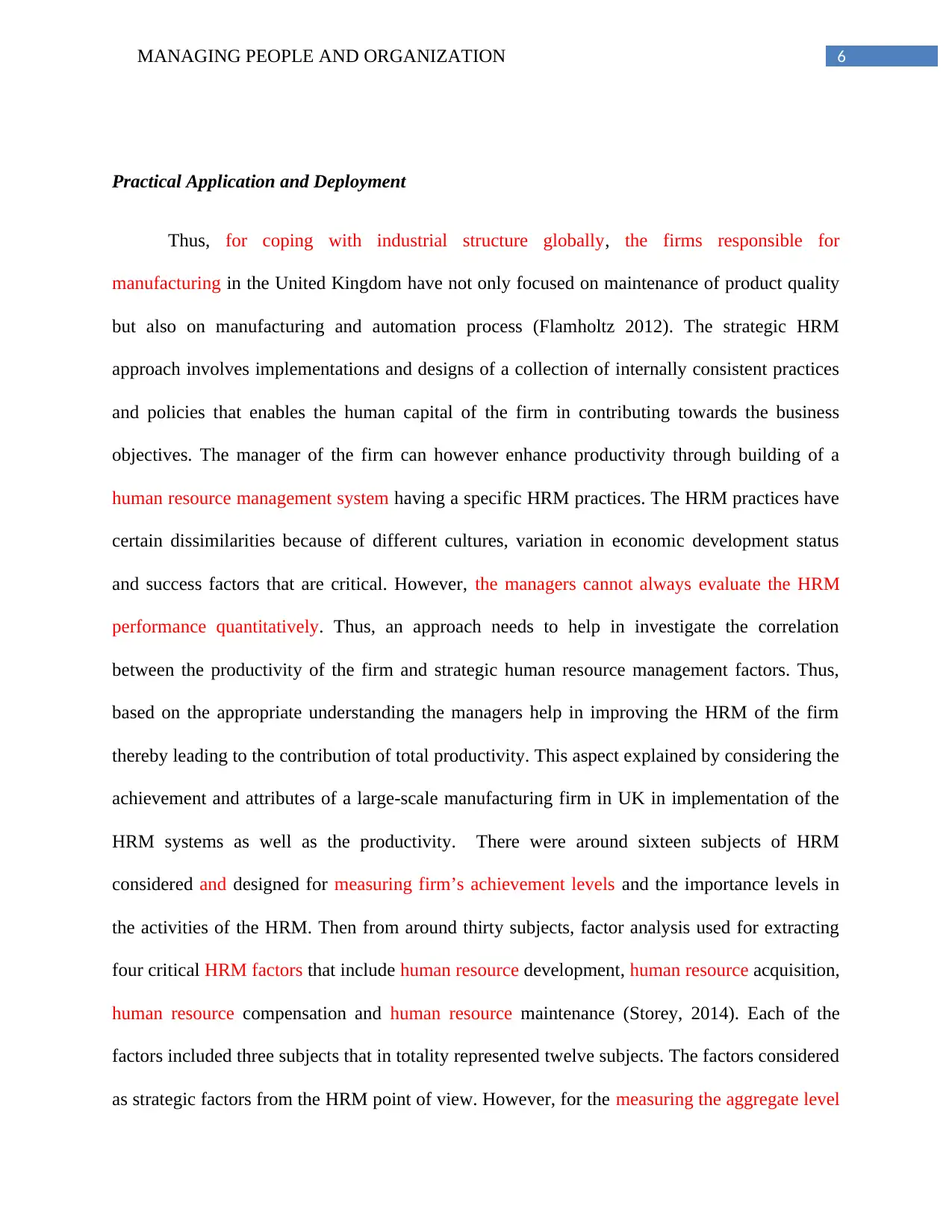
6MANAGING PEOPLE AND ORGANIZATION
Practical Application and Deployment
Thus, for coping with industrial structure globally, the firms responsible for
manufacturing in the United Kingdom have not only focused on maintenance of product quality
but also on manufacturing and automation process (Flamholtz 2012). The strategic HRM
approach involves implementations and designs of a collection of internally consistent practices
and policies that enables the human capital of the firm in contributing towards the business
objectives. The manager of the firm can however enhance productivity through building of a
human resource management system having a specific HRM practices. The HRM practices have
certain dissimilarities because of different cultures, variation in economic development status
and success factors that are critical. However, the managers cannot always evaluate the HRM
performance quantitatively. Thus, an approach needs to help in investigate the correlation
between the productivity of the firm and strategic human resource management factors. Thus,
based on the appropriate understanding the managers help in improving the HRM of the firm
thereby leading to the contribution of total productivity. This aspect explained by considering the
achievement and attributes of a large-scale manufacturing firm in UK in implementation of the
HRM systems as well as the productivity. There were around sixteen subjects of HRM
considered and designed for measuring firm’s achievement levels and the importance levels in
the activities of the HRM. Then from around thirty subjects, factor analysis used for extracting
four critical HRM factors that include human resource development, human resource acquisition,
human resource compensation and human resource maintenance (Storey, 2014). Each of the
factors included three subjects that in totality represented twelve subjects. The factors considered
as strategic factors from the HRM point of view. However, for the measuring the aggregate level
Practical Application and Deployment
Thus, for coping with industrial structure globally, the firms responsible for
manufacturing in the United Kingdom have not only focused on maintenance of product quality
but also on manufacturing and automation process (Flamholtz 2012). The strategic HRM
approach involves implementations and designs of a collection of internally consistent practices
and policies that enables the human capital of the firm in contributing towards the business
objectives. The manager of the firm can however enhance productivity through building of a
human resource management system having a specific HRM practices. The HRM practices have
certain dissimilarities because of different cultures, variation in economic development status
and success factors that are critical. However, the managers cannot always evaluate the HRM
performance quantitatively. Thus, an approach needs to help in investigate the correlation
between the productivity of the firm and strategic human resource management factors. Thus,
based on the appropriate understanding the managers help in improving the HRM of the firm
thereby leading to the contribution of total productivity. This aspect explained by considering the
achievement and attributes of a large-scale manufacturing firm in UK in implementation of the
HRM systems as well as the productivity. There were around sixteen subjects of HRM
considered and designed for measuring firm’s achievement levels and the importance levels in
the activities of the HRM. Then from around thirty subjects, factor analysis used for extracting
four critical HRM factors that include human resource development, human resource acquisition,
human resource compensation and human resource maintenance (Storey, 2014). Each of the
factors included three subjects that in totality represented twelve subjects. The factors considered
as strategic factors from the HRM point of view. However, for the measuring the aggregate level
Paraphrase This Document
Need a fresh take? Get an instant paraphrase of this document with our AI Paraphraser
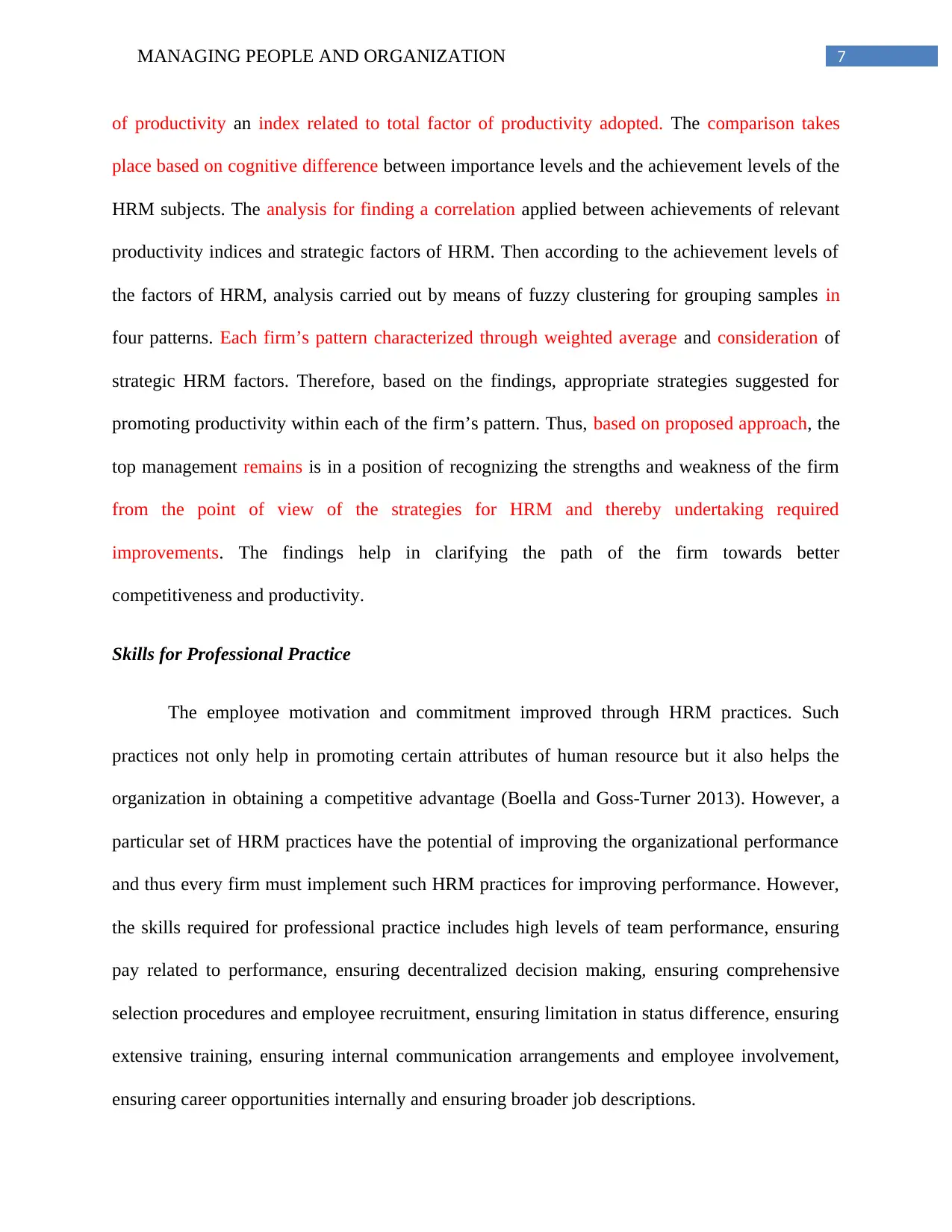
7MANAGING PEOPLE AND ORGANIZATION
of productivity an index related to total factor of productivity adopted. The comparison takes
place based on cognitive difference between importance levels and the achievement levels of the
HRM subjects. The analysis for finding a correlation applied between achievements of relevant
productivity indices and strategic factors of HRM. Then according to the achievement levels of
the factors of HRM, analysis carried out by means of fuzzy clustering for grouping samples in
four patterns. Each firm’s pattern characterized through weighted average and consideration of
strategic HRM factors. Therefore, based on the findings, appropriate strategies suggested for
promoting productivity within each of the firm’s pattern. Thus, based on proposed approach, the
top management remains is in a position of recognizing the strengths and weakness of the firm
from the point of view of the strategies for HRM and thereby undertaking required
improvements. The findings help in clarifying the path of the firm towards better
competitiveness and productivity.
Skills for Professional Practice
The employee motivation and commitment improved through HRM practices. Such
practices not only help in promoting certain attributes of human resource but it also helps the
organization in obtaining a competitive advantage (Boella and Goss-Turner 2013). However, a
particular set of HRM practices have the potential of improving the organizational performance
and thus every firm must implement such HRM practices for improving performance. However,
the skills required for professional practice includes high levels of team performance, ensuring
pay related to performance, ensuring decentralized decision making, ensuring comprehensive
selection procedures and employee recruitment, ensuring limitation in status difference, ensuring
extensive training, ensuring internal communication arrangements and employee involvement,
ensuring career opportunities internally and ensuring broader job descriptions.
of productivity an index related to total factor of productivity adopted. The comparison takes
place based on cognitive difference between importance levels and the achievement levels of the
HRM subjects. The analysis for finding a correlation applied between achievements of relevant
productivity indices and strategic factors of HRM. Then according to the achievement levels of
the factors of HRM, analysis carried out by means of fuzzy clustering for grouping samples in
four patterns. Each firm’s pattern characterized through weighted average and consideration of
strategic HRM factors. Therefore, based on the findings, appropriate strategies suggested for
promoting productivity within each of the firm’s pattern. Thus, based on proposed approach, the
top management remains is in a position of recognizing the strengths and weakness of the firm
from the point of view of the strategies for HRM and thereby undertaking required
improvements. The findings help in clarifying the path of the firm towards better
competitiveness and productivity.
Skills for Professional Practice
The employee motivation and commitment improved through HRM practices. Such
practices not only help in promoting certain attributes of human resource but it also helps the
organization in obtaining a competitive advantage (Boella and Goss-Turner 2013). However, a
particular set of HRM practices have the potential of improving the organizational performance
and thus every firm must implement such HRM practices for improving performance. However,
the skills required for professional practice includes high levels of team performance, ensuring
pay related to performance, ensuring decentralized decision making, ensuring comprehensive
selection procedures and employee recruitment, ensuring limitation in status difference, ensuring
extensive training, ensuring internal communication arrangements and employee involvement,
ensuring career opportunities internally and ensuring broader job descriptions.
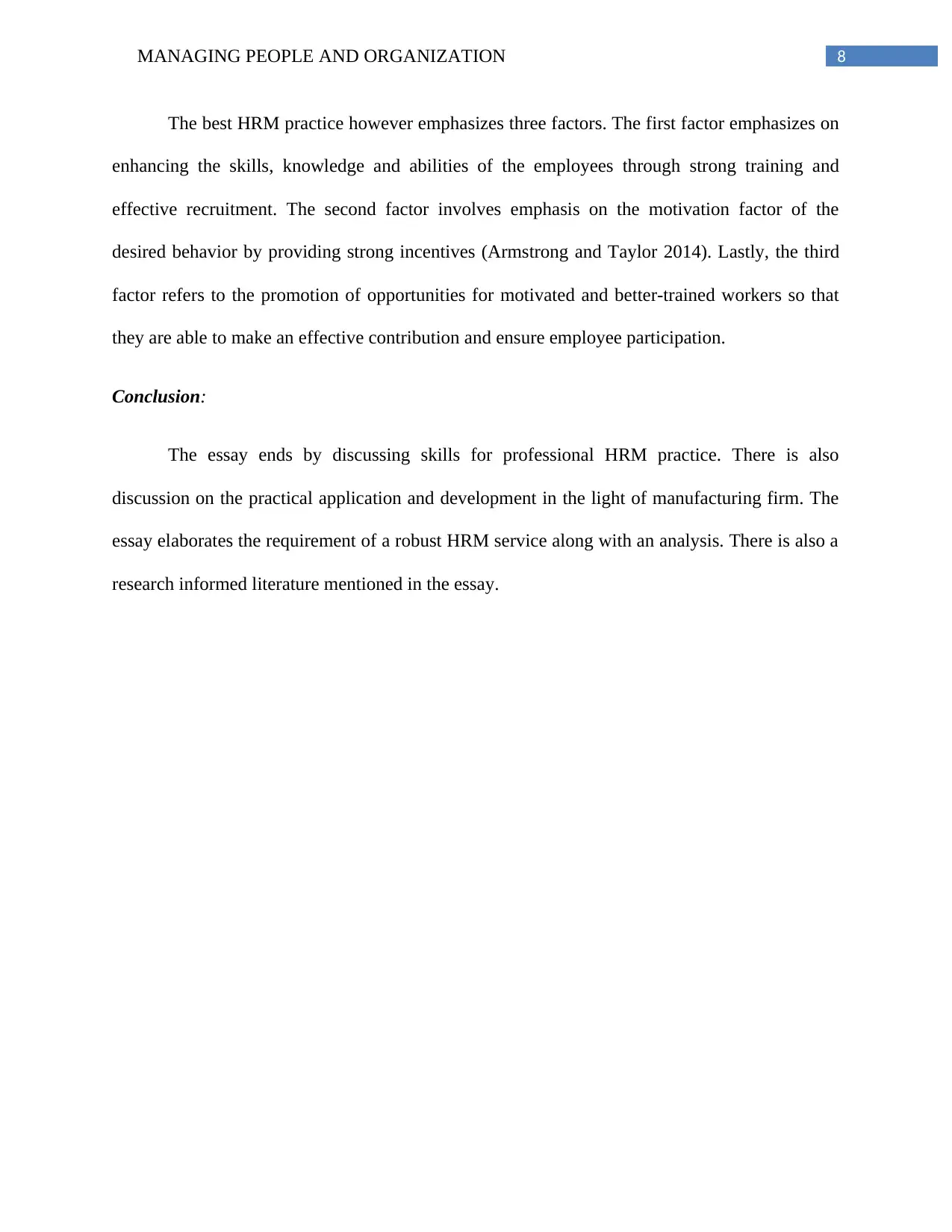
8MANAGING PEOPLE AND ORGANIZATION
The best HRM practice however emphasizes three factors. The first factor emphasizes on
enhancing the skills, knowledge and abilities of the employees through strong training and
effective recruitment. The second factor involves emphasis on the motivation factor of the
desired behavior by providing strong incentives (Armstrong and Taylor 2014). Lastly, the third
factor refers to the promotion of opportunities for motivated and better-trained workers so that
they are able to make an effective contribution and ensure employee participation.
Conclusion:
The essay ends by discussing skills for professional HRM practice. There is also
discussion on the practical application and development in the light of manufacturing firm. The
essay elaborates the requirement of a robust HRM service along with an analysis. There is also a
research informed literature mentioned in the essay.
The best HRM practice however emphasizes three factors. The first factor emphasizes on
enhancing the skills, knowledge and abilities of the employees through strong training and
effective recruitment. The second factor involves emphasis on the motivation factor of the
desired behavior by providing strong incentives (Armstrong and Taylor 2014). Lastly, the third
factor refers to the promotion of opportunities for motivated and better-trained workers so that
they are able to make an effective contribution and ensure employee participation.
Conclusion:
The essay ends by discussing skills for professional HRM practice. There is also
discussion on the practical application and development in the light of manufacturing firm. The
essay elaborates the requirement of a robust HRM service along with an analysis. There is also a
research informed literature mentioned in the essay.
⊘ This is a preview!⊘
Do you want full access?
Subscribe today to unlock all pages.

Trusted by 1+ million students worldwide
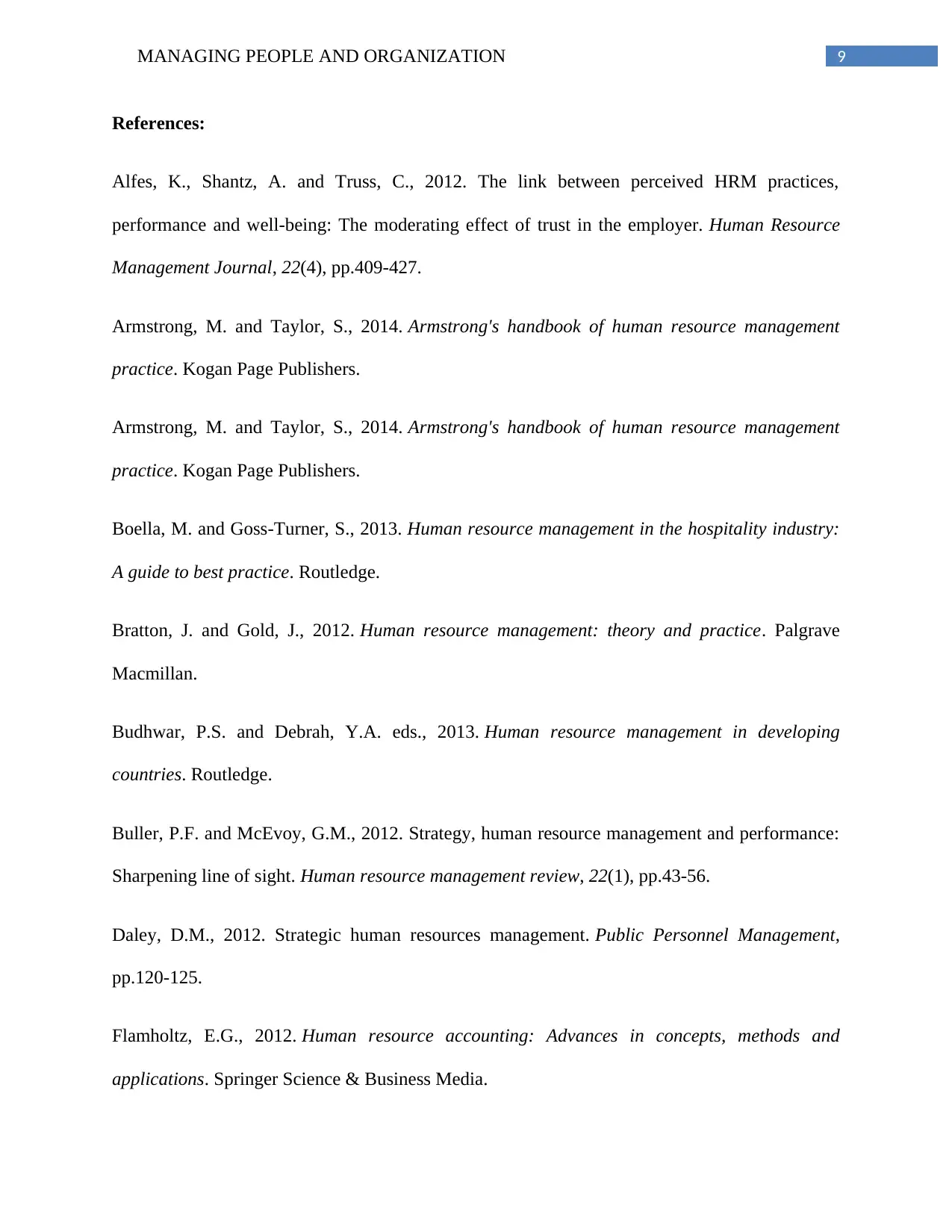
9MANAGING PEOPLE AND ORGANIZATION
References:
Alfes, K., Shantz, A. and Truss, C., 2012. The link between perceived HRM practices,
performance and well‐being: The moderating effect of trust in the employer. Human Resource
Management Journal, 22(4), pp.409-427.
Armstrong, M. and Taylor, S., 2014. Armstrong's handbook of human resource management
practice. Kogan Page Publishers.
Armstrong, M. and Taylor, S., 2014. Armstrong's handbook of human resource management
practice. Kogan Page Publishers.
Boella, M. and Goss-Turner, S., 2013. Human resource management in the hospitality industry:
A guide to best practice. Routledge.
Bratton, J. and Gold, J., 2012. Human resource management: theory and practice. Palgrave
Macmillan.
Budhwar, P.S. and Debrah, Y.A. eds., 2013. Human resource management in developing
countries. Routledge.
Buller, P.F. and McEvoy, G.M., 2012. Strategy, human resource management and performance:
Sharpening line of sight. Human resource management review, 22(1), pp.43-56.
Daley, D.M., 2012. Strategic human resources management. Public Personnel Management,
pp.120-125.
Flamholtz, E.G., 2012. Human resource accounting: Advances in concepts, methods and
applications. Springer Science & Business Media.
References:
Alfes, K., Shantz, A. and Truss, C., 2012. The link between perceived HRM practices,
performance and well‐being: The moderating effect of trust in the employer. Human Resource
Management Journal, 22(4), pp.409-427.
Armstrong, M. and Taylor, S., 2014. Armstrong's handbook of human resource management
practice. Kogan Page Publishers.
Armstrong, M. and Taylor, S., 2014. Armstrong's handbook of human resource management
practice. Kogan Page Publishers.
Boella, M. and Goss-Turner, S., 2013. Human resource management in the hospitality industry:
A guide to best practice. Routledge.
Bratton, J. and Gold, J., 2012. Human resource management: theory and practice. Palgrave
Macmillan.
Budhwar, P.S. and Debrah, Y.A. eds., 2013. Human resource management in developing
countries. Routledge.
Buller, P.F. and McEvoy, G.M., 2012. Strategy, human resource management and performance:
Sharpening line of sight. Human resource management review, 22(1), pp.43-56.
Daley, D.M., 2012. Strategic human resources management. Public Personnel Management,
pp.120-125.
Flamholtz, E.G., 2012. Human resource accounting: Advances in concepts, methods and
applications. Springer Science & Business Media.
Paraphrase This Document
Need a fresh take? Get an instant paraphrase of this document with our AI Paraphraser
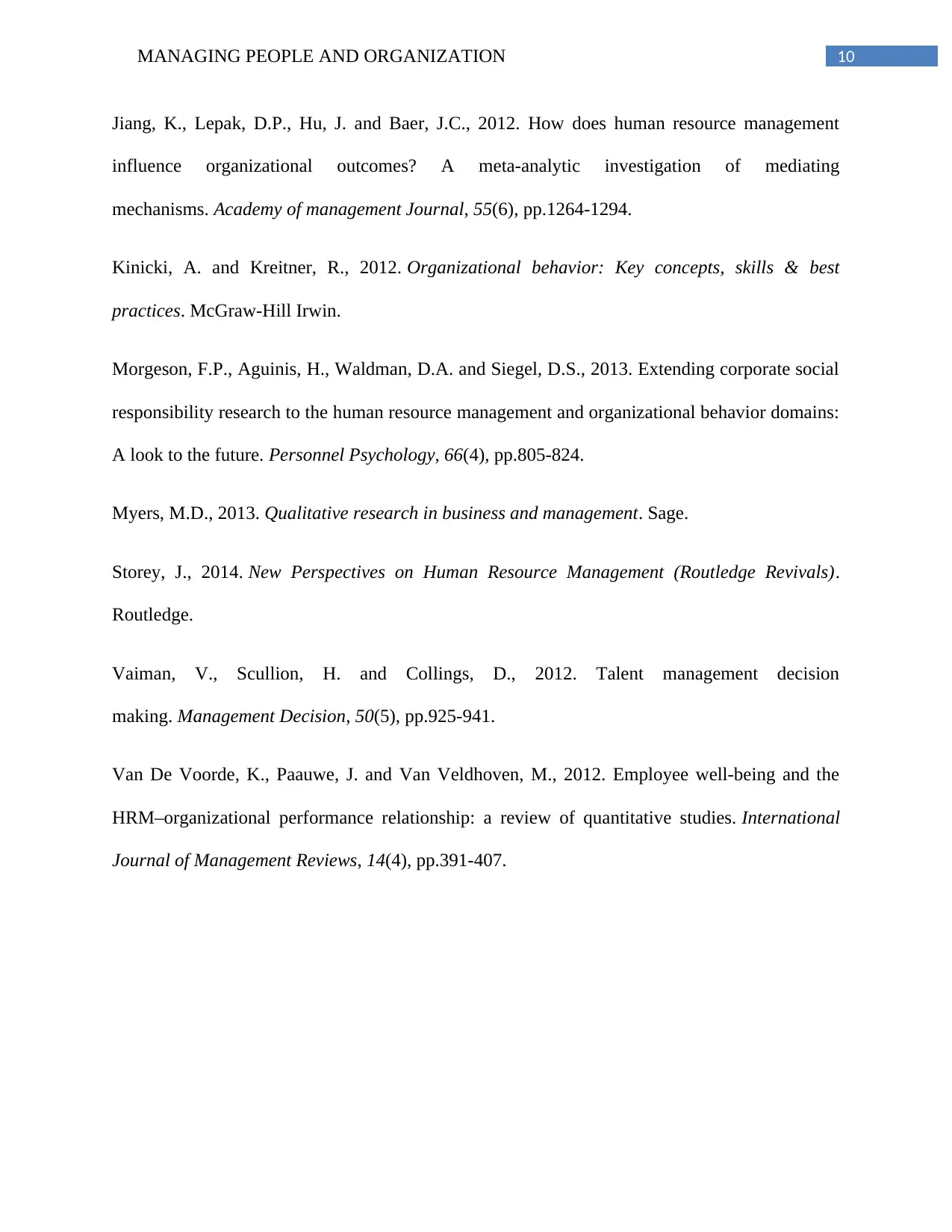
10MANAGING PEOPLE AND ORGANIZATION
Jiang, K., Lepak, D.P., Hu, J. and Baer, J.C., 2012. How does human resource management
influence organizational outcomes? A meta-analytic investigation of mediating
mechanisms. Academy of management Journal, 55(6), pp.1264-1294.
Kinicki, A. and Kreitner, R., 2012. Organizational behavior: Key concepts, skills & best
practices. McGraw-Hill Irwin.
Morgeson, F.P., Aguinis, H., Waldman, D.A. and Siegel, D.S., 2013. Extending corporate social
responsibility research to the human resource management and organizational behavior domains:
A look to the future. Personnel Psychology, 66(4), pp.805-824.
Myers, M.D., 2013. Qualitative research in business and management. Sage.
Storey, J., 2014. New Perspectives on Human Resource Management (Routledge Revivals).
Routledge.
Vaiman, V., Scullion, H. and Collings, D., 2012. Talent management decision
making. Management Decision, 50(5), pp.925-941.
Van De Voorde, K., Paauwe, J. and Van Veldhoven, M., 2012. Employee well‐being and the
HRM–organizational performance relationship: a review of quantitative studies. International
Journal of Management Reviews, 14(4), pp.391-407.
Jiang, K., Lepak, D.P., Hu, J. and Baer, J.C., 2012. How does human resource management
influence organizational outcomes? A meta-analytic investigation of mediating
mechanisms. Academy of management Journal, 55(6), pp.1264-1294.
Kinicki, A. and Kreitner, R., 2012. Organizational behavior: Key concepts, skills & best
practices. McGraw-Hill Irwin.
Morgeson, F.P., Aguinis, H., Waldman, D.A. and Siegel, D.S., 2013. Extending corporate social
responsibility research to the human resource management and organizational behavior domains:
A look to the future. Personnel Psychology, 66(4), pp.805-824.
Myers, M.D., 2013. Qualitative research in business and management. Sage.
Storey, J., 2014. New Perspectives on Human Resource Management (Routledge Revivals).
Routledge.
Vaiman, V., Scullion, H. and Collings, D., 2012. Talent management decision
making. Management Decision, 50(5), pp.925-941.
Van De Voorde, K., Paauwe, J. and Van Veldhoven, M., 2012. Employee well‐being and the
HRM–organizational performance relationship: a review of quantitative studies. International
Journal of Management Reviews, 14(4), pp.391-407.
1 out of 11
Related Documents
Your All-in-One AI-Powered Toolkit for Academic Success.
+13062052269
info@desklib.com
Available 24*7 on WhatsApp / Email
![[object Object]](/_next/static/media/star-bottom.7253800d.svg)
Unlock your academic potential
Copyright © 2020–2025 A2Z Services. All Rights Reserved. Developed and managed by ZUCOL.





